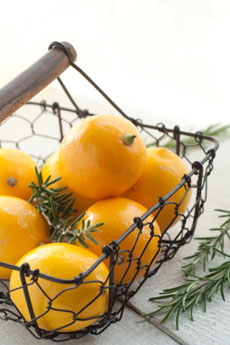TIP OF THE DAY: Meyer Lemons
|
Now in season through March, the Meyer lemon is a foodie favorite: bright citrus flavor with less pucker, owing to less acid. For decades it was available largely at California farmers’ markets, where it was “discovered” in the 1970s by Alice Waters and other pioneer chefs of “California cuisine.”
Chefs and customers alike loved the Meyer lemon for its mild, sweet, juicy flesh. With growing popularity, it entered commercial production and national availability. In its native China, the Meyer lemon is commonly grown in garden pots as an ornamental tree (you can buy one for your home here). It was brought to the United States in 1908 by Frank Nicholas Meyer, an employee of the United States Department of Agriculture who was exploring China for “new” fruits and vegetables. The Meyer lemon (botanical name Citrus × meyeri) is a hybrid, believed to be a cross between a true lemon and either a mandarin or common orange, both native to China. As a result, Meyer lemons are slightly sweeter and much less acidic than the common “supermarket lemons,” Eureka and Lisbon (see all the types of lemons in our Lemon Glossary). |
 A basket of lovely Meyer lemons, waiting to become part of a recipe. Photo by Elise Bakketun | IST. |
|
|
Meyer lemons are smaller than regular lemons and rounder, with a thin peel, which tends to golden hues rather than bright yellow. They’re more expensive than regular lemons, but also tend to provide much more juice. *The Eureka (botanical name Citrus × limon) is the predominant lemon grown in most countries, with the exception of Italy, Spain and some other Mediterranean nations. Because the tree is thornless and a year-round bearer, it came to rival the then-predominant Lisbon variety (which looks similar, but the Eureka has a far more prominent nipple end). Try these recipes from Melissas.com.
|
||


